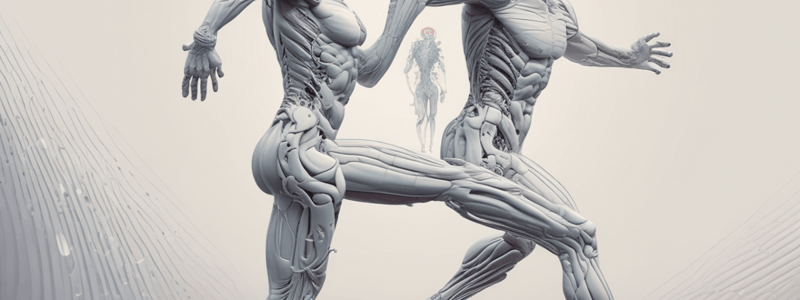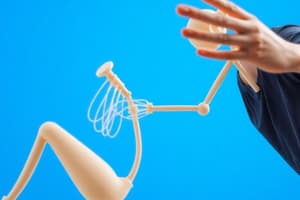Podcast
Questions and Answers
Neuromuscular control is the control of human movement by a complex interaction between the ______ and muscle systems
Neuromuscular control is the control of human movement by a complex interaction between the ______ and muscle systems
neural
High ______ during movement is at the beginning of learning new tasks and results in increases in errors executing movements
High ______ during movement is at the beginning of learning new tasks and results in increases in errors executing movements
variability
As movements are practiced, the ______ decreases and the movement becomes more accurate and 'patterned'
As movements are practiced, the ______ decreases and the movement becomes more accurate and 'patterned'
variability
Some ______ in movement is a good thing, as it can help reduce the risk of injury due to repetitive loading patterns
Some ______ in movement is a good thing, as it can help reduce the risk of injury due to repetitive loading patterns
Motor learning is the adaptation of ______ of movement that occurs with task rehearsal
Motor learning is the adaptation of ______ of movement that occurs with task rehearsal
Initial performance gains in strength training are initially due to ______ adaptations before hypertrophy occurs.
Initial performance gains in strength training are initially due to ______ adaptations before hypertrophy occurs.
Neuromuscular adaptations is a development of a pattern of repeated movements resulting in more ______ movement
Neuromuscular adaptations is a development of a pattern of repeated movements resulting in more ______ movement
Those with ______ have exhibited altered neuromuscular control in comparison to healthy individuals.
Those with ______ have exhibited altered neuromuscular control in comparison to healthy individuals.
Muscle acts in a ______ force and creates motion cause it crosses one or two joints.
Muscle acts in a ______ force and creates motion cause it crosses one or two joints.
The functional effect produced by a ______ muscle force is called a torque.
The functional effect produced by a ______ muscle force is called a torque.
Skeletal muscle does: production of ______ movement, maintain posture and enhance joint stability.
Skeletal muscle does: production of ______ movement, maintain posture and enhance joint stability.
EMG can look at the relationship between different muscles as a ______ diagram.
EMG can look at the relationship between different muscles as a ______ diagram.
Groups of muscles are within ______ that are then surrounded by fascia.
Groups of muscles are within ______ that are then surrounded by fascia.
The exact mechanical interaction depends on the ______ that is being applied or generated.
The exact mechanical interaction depends on the ______ that is being applied or generated.
Hill's Muscle Model consists of Contractile component, Parallel elastic component, and Series elastic component, which includes the ______.
Hill's Muscle Model consists of Contractile component, Parallel elastic component, and Series elastic component, which includes the ______.
Muscle force varies in proportion to the amount of overlap between ______ and myosin filaments.
Muscle force varies in proportion to the amount of overlap between ______ and myosin filaments.
Muscle morphology is one of the factors influencing ______ generation.
Muscle morphology is one of the factors influencing ______ generation.
The ______ tension relationship represents the static capability of a muscle and indicates the force that muscle can exert at different lengths.
The ______ tension relationship represents the static capability of a muscle and indicates the force that muscle can exert at different lengths.
Translating to an angle ______ relationship is confounded by three factors:
Translating to an angle ______ relationship is confounded by three factors:
By applying a quick ______ to muscle while it's contracting an additional force can be generated.
By applying a quick ______ to muscle while it's contracting an additional force can be generated.
Negative work: while being ______, the muscle is lengthening and therefore, negative work is being performed and energy is being absorbed.
Negative work: while being ______, the muscle is lengthening and therefore, negative work is being performed and energy is being absorbed.
Aging increases ______ stiffness and increases risk of injury.
Aging increases ______ stiffness and increases risk of injury.
The ability to produce max ______ in a muscle is affected by the velocity of the contraction.
The ability to produce max ______ in a muscle is affected by the velocity of the contraction.
The greatest ______ are achieved when being actively stretched under load.
The greatest ______ are achieved when being actively stretched under load.
Resistive force increases with increasing ______ velocity, thus, in concentric contraction, the viscous damping decreases the net force output by muscle.
Resistive force increases with increasing ______ velocity, thus, in concentric contraction, the viscous damping decreases the net force output by muscle.
Cross bridge recycling occurs with greater frequency with increasing ______ of concentric or eccentric contraction.
Cross bridge recycling occurs with greater frequency with increasing ______ of concentric or eccentric contraction.
Power is the rate that ______ can be performed, important in high performance sport.
Power is the rate that ______ can be performed, important in high performance sport.
Force decreases with increasing ______ and vice versa.
Force decreases with increasing ______ and vice versa.
One can't determine the function or contribution of a muscle to a joint movement by looking at the ______ points.
One can't determine the function or contribution of a muscle to a joint movement by looking at the ______ points.
Most muscles only cross ______ joint.
Most muscles only cross ______ joint.
Power = ______ x velocity
Power = ______ x velocity
In the case of eccentric contraction, greater ______ is required to stretch and break the cross bridge bonds with increasing lengthening velocity
In the case of eccentric contraction, greater ______ is required to stretch and break the cross bridge bonds with increasing lengthening velocity
The ability to produce max ______ in a muscle is affected by the velocity of the contraction
The ability to produce max ______ in a muscle is affected by the velocity of the contraction
The functional effect produced by a ______ muscle force is called a torque
The functional effect produced by a ______ muscle force is called a torque
In concentric contraction, the viscous damping decreases the net ______ output by muscle
In concentric contraction, the viscous damping decreases the net ______ output by muscle
There is an optimum ______ velocity that maximises power output
There is an optimum ______ velocity that maximises power output
Aging increases muscular ______ and increases risk of injury.
Aging increases muscular ______ and increases risk of injury.
The ability to produce max force in a muscle is affected by the ______ of the contraction.
The ability to produce max force in a muscle is affected by the ______ of the contraction.
Groups of muscles are controlled by a single muscle to move most body ______.
Groups of muscles are controlled by a single muscle to move most body ______.
The functional effect produced by a muscle force is called a ______.
The functional effect produced by a muscle force is called a ______.
The shape of the angle ______ relationship varies amongst muscles.
The shape of the angle ______ relationship varies amongst muscles.
The faster the movement is, the harder it is to produce max ______.
The faster the movement is, the harder it is to produce max ______.
Muscles may produce very ______ and fine or very large and powerful movement.
Muscles may produce very ______ and fine or very large and powerful movement.
Force generation: tendons and muscles work together to absorb or generate ______.
Force generation: tendons and muscles work together to absorb or generate ______.
The exact mechanical interaction depends on the force that is being applied or generated, the speed of the muscle action and the ______ in the tendon.
The exact mechanical interaction depends on the force that is being applied or generated, the speed of the muscle action and the ______ in the tendon.
Muscle force varies in proportion to the amount of overlap between actin and myosin ______.
Muscle force varies in proportion to the amount of overlap between actin and myosin ______.
The functional effect produced by a muscle force is called a ______.
The functional effect produced by a muscle force is called a ______.
The ability to produce max force in a muscle is affected by the ______ of the contraction.
The ability to produce max force in a muscle is affected by the ______ of the contraction.
Flashcards are hidden until you start studying
Study Notes
Neuromuscular Control and Learning
- Neuromuscular control involves a complex interaction between the nervous system and muscle systems to manage human movement.
- High errors in movement execution are common at the beginning of learning new tasks, leading to decreased accuracy initially.
- As practice continues, movement errors decrease, resulting in more accurate and 'patterned' movements.
- Allowing some variability in movement is beneficial as it helps minimize the risk of injury from repetitive loading patterns.
- Motor learning entails adaptation in movement patterns occurring through task rehearsal.
Muscle Function and Adaptations
- Initial strength training performance gains are primarily due to neuromuscular adaptations before muscle hypertrophy begins.
- Neuromuscular adaptations develop patterns of repeated movements, resulting in improved movement efficiency.
- Individuals with specific neuromuscular disorders exhibit altered control compared to healthy individuals.
- Muscle generates force when crossing one or two joints; this motion creates torque.
- Skeletal muscle is essential for movement production, maintaining posture, and enhancing joint stability.
Muscle Interaction and Mechanics
- Electromyography (EMG) analyzes the relationship between different muscle groups and their functions.
- Muscle groups form within compartments surrounded by fascia, affecting mechanical interaction.
- Hill's Muscle Model consists of components that detail muscle function and behavior under load.
- Muscle force is related to the degree of overlap between actin and myosin filaments, which influences force generation.
Force Relationships and Aging Effects
- The length-tension relationship indicates a muscle's static capability and force exertion at varying lengths.
- Certain factors complicate the translation to an angle-velocity relationship in muscle dynamics.
- Applying rapid tension to a contracting muscle can increase generated force.
- Negative work occurs during lengthening contractions where energy is absorbed, increasing injury risk as aging leads to stiffer muscles.
Performance Factors
- Maximum muscle force production is influenced by contraction velocity; greater velocity can yield higher power output but may decrease overall force.
- Elastic properties of muscles and tendons play crucial roles in mechanical interactions during movement.
- Power is defined as the rate at which work is done, crucial for high-performance sports activities.
- Understanding joint mechanics requires analysis beyond just muscle attachment points, with most muscles crossing a single joint.
Muscle Behavior and Force Generation
- Eccentric contractions require greater force to stretch and disrupt cross-bridge bonds, especially with increasing lengthening velocity.
- There exists an optimal velocity for maximizing power output during contractions.
- The interaction between tendons and muscles is vital for energy absorption and generation during movement.
- Muscle force varies with the degree of actin-myosin overlap, which is essential for effective force generation.
Summary of Muscle Dynamics
- The functional effect of muscle force is identified as torque, vital for joint movement.
- Force generation efficiency varies with movement speed, with considerations for both fine and powerful movements.
- The relationship between muscle contraction dynamics is pivotal for designing effective training and rehabilitation protocols.
Studying That Suits You
Use AI to generate personalized quizzes and flashcards to suit your learning preferences.




